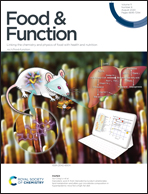LUAD transcriptomic profile analysis of d-limonene and potential lncRNA chemopreventive target†
Abstract
D-Limonene, a type of natural extract obtained from citrus oils, was reported to have anti-cancer effects and be well-tolerated by cancer patients. Despite arousing interest as a cancer chemopreventive substance, the transcriptomic profile of D-limonene in humans is poorly understood. Based on the results of the transcriptomic profiling, a lncRNA named protein disulfide isomerase family A member three pseudogene (PDIA3P1) was found to be regulated by D-limonene. PDIA3P1 is an oncogene verified by three lung adenocarcinoma (LUAD) datasets. The knockdown of PDIA3P1 with siRNA decreased the viability, invasion, migration, and proliferation of LUAD cells. Based on The Cancer Genome Atlas (TCGA) LUAD datasets, PDIA3P1 regulates functions and pathways mainly including lipid metabolism, immunity, and the change of the chromosome structure. This study comprehensively performs the transcriptomic analysis of the D-limonene regulation on LUAD, and reveals that PDIA3P1 may be the mediator in helping D-limonene to prevent and suppress LUAD via lipid metabolism, immunity pathway, and the change in the chromosome structure.



 Please wait while we load your content...
Please wait while we load your content...